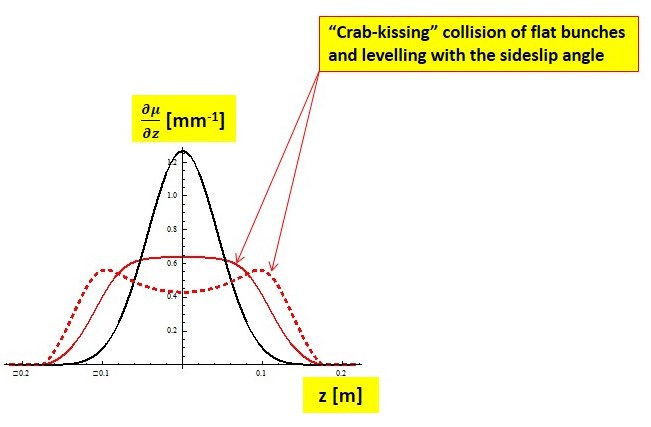![]() Pile-up management at HL-LHC and Crab-Kissing
Pile-up management at HL-LHC and Crab-Kissing
Crab-kissing collision to level the luminosity and strongly mitigate the pile-up density at HL-LHC.
Image credit: S. Fartoukh (CERN)
The HiLumi LHC Design Study investigates novel technologies and concepts to extend the discovery potential of the LHC. The overall scheme targets an integrated luminosity higher by a factor of 10 with respect to the LHC, but without compromising on the quality of the data delivered, both in terms of total number of interactions per bunch crossing (pile-up), but also their line density along the luminous region. A novel collision scheme might lead the way to succeed.
This so-called crab-kissing scheme is complementary to the baseline crab-crossing scheme already in use. It assumes, however, that additional crab-cavities are installed in order to achieve a bunch rotation in the plane perpendicular to the crossing plane (the so-called parallel separation plane). In this way the two beams collide with a side-slip angle in one of the two transverse planes, for levelling the collision time and therefore the luminosity, while mitigating the interaction rate at the centre of the luminous region, and therefore spreading out the events more efficiently over the luminous region.
Assuming a double harmonic radio-frequency system for the HL-LHC, as already planned for other purposes, the longitudinal bunch distribution can be made more uniform. Then combined with the crab-kissing scheme, a pile up density of only 0.5-0.6 event /mm is within reach for the HL-LHC, which would definitely maximise the efficiency of the new detector and might even be partly used to further increase peak and integrated luminosity of the HL-LHC
The connection between pile-up density and crab-cavity via the crab-kissing scheme, gives an additional boost to this very challenging RF device which remains a keystone of the HL-LHC project. First beam dynamics analysis were reported at the 6th crab-cavity workshop CC13, validating the soundness of the proposal, in particular in terms of beam-beam effect.

